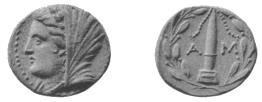
FIG. 179.



[British Museum Catalog of Greek Coins, Thessaly to Aetolia, by P. Gardner, 1883.
Do., Corinth, Colonies of Corinth, &c., by B. V. Head, 1889.]
(i) The earliest money of Epirus consists of silver coins of Corinthian types and standard, struck before Epirus became a kingdom, B.C. 342, at the town of Ambracia, and of bronze coins of Cassope, Elea, and the Molossi, anterior to the regal period. (ii) The second period of the coinage includes that of the kings, Alexander the son of Neoptolemus, B.C. 342-326, and Pyrrhus, 295-272. (iii) B.C. 238-168. There are bronze coins reading ΑΠΕΙΡΩΤΑΝ, which are certainly earlier than the abolition of the monarchy, but the regular series of the Epirote Federal money did not begin till the Republic was fully constituted on the death of Ptolemy, the last of the royal race of the Aeacidae, B.C. 238.
The autonomous coinage appears to have gone on in some of the towns of Epirus side by side with the Federal money. After B.C. 168, when Epirus was devastated by the Romans and its inhabitants sold into slavery, all coinage ceased.
The prevailing types on the coins of Epirus are the heads of Zeus Dodonaeos and of Dione his spouse. The former is distinguished by his wreath of oak-leaves from the sacred oracular oak of Dodona. The latter wears a veil and a laureate stephanos (see B. M. C., Thes., Pl. XVII). The gold and silver coins of the kings were probably struck in Italy and Sicily.
Ambracia. The most important colony of Corinth on the Ambracian Gulf. Silver staters of Corinthian type circ. B.C. 480-342, and later (B. M. C., Cor., Pls. XXVII-XXIX). Inscr., Α, ΑΜ, ΑΜΠΡΑΚΙΩΤΑΝ, or ΑΜΒΡΑΚΙΩΤΑΝ. Of these staters more than a hundred varieties are known.

| Head of Dione veiled (Fig. 179). | ΑΜ, ΑΜΒΡΑ,&c. Obelisk bound with
taenia all in wreath. AR 63 grs.
|
| Heads of Dione, Apollo, Athena, &c. | Similar. Æ .85
|
The obelisk represented on the coins of Ambracia is the sacred conical stone (βαιτυλιον) of the Apollo ‘Aγυιευς of Ambracia (Preller, Gr. Myth., i. p. 211).
There are also bronze coins with Acarnanian types:—Head of Herakles or Achelous, rev. Apollo Aktios seated, or Crab or Rushing bull; also with Aetolian or Epirote types:—
| Head of Apollo radiate or laureate. [B. M. C., Thes., Pl. XVIII. 4.] |
Apollo naked, advancing with bow.
Æ .9-.7
|
| Id. | Zeus with aegis and fulmen. Æ .9-.65
|
| Head of Zeus. | Griffin; magistrate’s name in nom. case.
Æ .75
|
See also Imhoof (Mon. gr., p. 137).
Athamanes. On the fall of the kingdom of Epirus this tribe rose to be independent and struck bronze coins.
| Head of Dione veiled. [B. M. C., Thes., Pl. XVIII. 5.] |
ΑΘΑΜΑΝΩΝ Athena standing, hold-
ing owl and spear. Æ .65
|
| Head of Apollo. [Imhoof, Mon. gr., 138.] |
ΑΘΑΜΑΝΩΝ Bulkhead. Æ .7
|
For a coin of the Amphilochian Argos, bearing the name ΑΜΥΝΑΝ- ΔΡΟΣ, who is perhaps identical with Amynander, king of the Athamanes, see infra, p. 329, and Z. f. N., vii. 127.
Buthrotum. Colonial and Imperial, Augustus—Tiberius, with Latin inscriptions, C. I. BVT. or C. A. BVT. (Colonia Julia or Augusta Buthro- tum) and names of Duumviri, with titles, II VIR EX D. D. IIVIIR Q[uinquennalis], &c. For varieties, see Imhoof (Mon. gr., p. 138, and N. Z., xxxiii. 26).
Cassope. Silver and bronze, with inscr. ΚΑΣΣΩΠΑΙΩΝ on obverse or reverse.
| Head of Aphrodite wearing stephanos. | Coiled serpent. Æ .8
|
| Id. [B. M. C., Thes., Pl. XVIII. .7] | Dove flying in wreath. Æ .85
|
| Head of Aphrodite wearing stephanos. [B. M.; Photiades Cat., 228.] |
Cista mystica with serpent twined
round it. AR 75.3 grs.
|
| Head of Zeus Dodonaeos, and magis- trate’s name. | Eagle on fulmen, in oak-wreath [Brit.
Mus. Guide, Pl. LV. 18] AR 79-66 grs.
|
| Head of Aphrodite. | Dove. Æ .75
|
| Head of Dionysos. | Amphora [B. M. C., Thes., Pl. XXXII.
6]. Æ .7
|
| Bull’s head facing. | Serpent [B. M. C., Thes., Pl. XXXII. 5].
Æ .55
|
This town also struck bronze coins in Roman times with the inscr. ΚΑΣΣΩΓΙΑΙΩΝ ΜΟΛΟΣΣΩΝ (B. M. C., Thes., &c., p. 99).
Dodona (?). See infra, p. 325.
Elea in Thesprotia. The bronze coinage of this town belongs to the time of Philip of Macedon (over whose coins some of the specimens are restruck) before B.C. 342. As Leake remarks (Num Hell., p. 48), the types relating to the infernal regions identify the district with the Eleatis through which flowed the rivers Acheron and Cocytus.
| Head of Persephone facing. [N. C., 1900, p. 11.] |
ΕΛΕΑΤΑΝ Kerberos [B. M. C., Thes.,
Pl. XVIII. 11]. Æ .8
|
| Pegasos. | ΕΛΕΑΤ Trident [Ib., Pl. XVIII. 10]
Æ .55
|
Molossi. The Molossians were the predominant people in Epirus before Alexander the son of Neoptolemus became king, B.C. 342. Con- cerning the celebrated breed of Molossian dogs, cf. Hor. Sat. ii. 6. 114. According to Nicander of Colophon (Pollux v. 5. 1) they were descended from the famous brass dog made by Hephaestos.
| Molossian dog standing. [N. C., 1903, Pl. X. 5.] |
ΜΟΛΟΣΣΩΝ Fulmen. AR 35 grs.
|
| Dog lying. [Imhoof, Mon. gr., 140.] | Μ Ο Fulmen. AR 15 grs.
|
| Head of Athena in crested Athenian
helmet. [B. M. C., Thes., Pl. XVIII. 13.] |
ΜΟΛΟΣΣΩΝ Eagle on fulmen. Æ .8
|
| ΜΟΛΟΣΣΩΝ round rim of circular shield, on which, fulmen. | Fulmen in wreath [B. M. C., Thes.,
Pl. XVIII. 14]. Æ .75
|
| Head of Zeus. [Imhoof, Mon. gr., 141.] | Fulmen between Μ and cornucopiae, all
in oak-wreath. Æ 1.
|
Nicopolis. This town was founded by Augustus after the battle of Actium. Imperial coins from Augustus to Gallienus.
Types (B. M. C., Thes., Pl. XIX) usually referring to the quinquennial Actian games held at Nicopolis in honour of the Actian Apollo, and in memory of the battle of Actium. Inscr., ΝΙΚΟΓΙΟΛΙC ΙΕΡΑ, ΝΙΚΟΓΙΟ- ΛΕWC, ΙΕΡΑC ΝΙΚΟΓΙΟΛЄΩC, ΑΥΓΟΥCΤΟC ΚΤΙCΤΗC, CΕΒΑCΤΟΥ ΚΤΙCΜΑ, ΝЄΙΚΟΠΟΛЄΩC ΙΕΡΑC ΝΑΥΑΡΧΙΔΟC, ΝΕΙΚΟΠΟΛΕΩC ΙΕΡΑC ΑCΥΛΟΥ(?), Η ΠΡΟC ΑΚΤ, &c., ΤΡΑΙΑΝΟC CWΤΗΡ ΠΟΛΕWC Rev. ΑΓΙΟΛΛWΝ ΛΕΥΚΑΤΗC (Imhoof, Mon. gr., p. 141), also ΦΙΝΑΙΟC accompanying the type of Asklepios standing. Games, ΑΚΤΙΑ, on AR Quinarii of Ant. Pius and Faustina Sen. (B. M. C., Thes., Pl. XIX. 8), and on Æ of Hadrian (Hunter Cat., Pl. XXXI. 16). On some coins of Nicopolis, Hadrian has the title ΓΙΑΝΕΛΛΗΝΙΟC.
Pandosia, on the river Acheron.
| Head of Dodonaean Zeus, and magis- trate’s name. | ΠΑΝ Fulmen in oak-wreath [B. M. C.,
Pl. XXXII. 9]. Æ .75
|
Phoenice was, according to Polybius (ii. 5. 8), the most important city
| Head of Zeus (?). | ΦΟΙΝΙΚΑΙΕΩΝ Fulmen in wreath.
Æ .7
|
| Bust of Artemis. | „ Spear-head [B. M. C.,
Thes., Pl. XXXII. 10, 11]. Æ .7
|
Also Imperial of Claudius, Nero, and Trajan.
Alexander, son of Neoptolemus, B.C. 342-326. The gold coins of this king were probably struck in southern Italy, whither Alexander went in B.C. 332 to aid the Greek cities against the Lucanians and Bruttians. In style the remarkable gold stater in the British Museum differs curiously from the specimen in the Hunter Coll. and from the silver staters, and the weight of the latter, 165 grs. (that of the coins of Corcyra), may possibly indicate an Epirote origin. On the whole, however, I am inclined to attribute all Alexander’s coins to the Locrian or possibly to the Syracusan mint. The skilful engravers and die-sinkers of Italy and Sicily may well have been chosen to design and strike coins for various kings and for states where mints did not exist at all, or where the die-engravers were only capable of executing rough imitations of the works of more practised artists. Cf. J. H. S., 1907, p. 149. The ruder bronze money is undoubtedly Epirote.
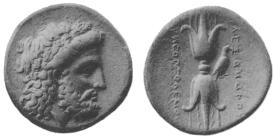
| Head of Zeus Dodonaeos, wearing oak- wreath. [B. M. C., Thes., Pl. XX. 1, and Hunter, Pl. XXXI. 17.] | ΑΛΕΞΑΝΔΡΟΥ ΤΟΥ ΝΕΟΠΤΟ-
ΛΕΜΟΥ Fulmen (Fig. 180).
AV Stater 132 grs., AR Stater 165 grs.
|
| Head of Helios. [B. M. C., Thes., Pl. XX. 2.] |
ΑΛΕΞ Fulmen. AV 1/12 Stater.
|
| Id. | Id. AR Diobol.
|
| Eagle, wings closed, between tripod and olive-spray. | ΑΛΕΞΑ ΤΟΥ ΝΕ Fulmen in olive-
wreath. Æ .65
|
Pyrrhus, B.C. 295-272. Pyrrhus, like Alexander, struck coins in various parts of his dominions, chiefly in Italy and Sicily, but also in Macedon and perhaps in Epirus. All the gold coins and the silver pieces of 90 grs. are of Syracusan fabric, as are also the finest of his bronze coins. His tetradrachms and didrachms of Attic weight appear to have been issued at Locri in Bruttium; his Macedonian bronze coins are
Inscr. ΒΑΣΙΛΕΩΣ ΠΥΡΡΟΥ, usually at full length except on the Macedonian coins and on some of the Epirote (?) bronze pieces, where the name appears in monogram.
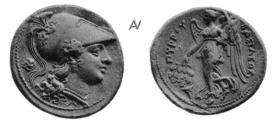
| Head of Athena; symbol: owl (Fig. 181). | Nike with oak-wreath and trophy.
AV Stater.
|
| Head of Artemis. | Id. [Brit. Mus. Guide, Pl. XLVI. 25,
26]. AV ½ Stater.
|
The obv. of the gold stater is almost identical with that of the Aetolian League (p. 334 infra). They are both probably by the same (possibly Syracusan) engraver.
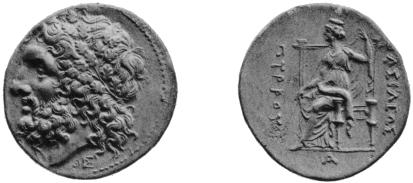
| Head of Dodonaean Zeus in oak-wreath. | Dione with sceptre, enthroned (Fig. 182).
AR Tetradr.
|
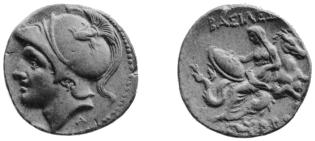
| Head of Achilles, helmeted (Fig. 183). | Thetis veiled, riding on hippocamp,
and holding shield of Achilles.
AR Didr.
|
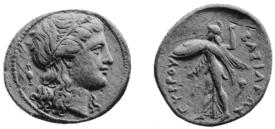
| Head of Persephone with flowing hair and corn-wreath (Fig. 184). | Athena with spear and shield, in fight-
ing attitude. AR 90 grs.
|
| ΦΘΙΑΣ Head of Phthia veiled. | Fulmen [Gardner, Types, Pl. XI. 27].
Æ 1.1
|
| Head of Persephone as above. | Demeter enthroned [B. M. C., Thes., Pl.
XX. 14]. Æ .95
|
| Head of Athena. [B. M. C., Thes., Pl. XX. 15.] |
Ear of corn in oak-wreath. Æ .75
|
| Head of Athena. [Z. f. N., xxi. Pl. VIII. 10.] |
Naked warrior charging. Æ .75
|
| Macedonian shield, on it ΠΥΡ in mono- gram. | ΒΑΣΙ Macedonian helmet in oak-
wreath [B. M. C., Thes., Pl. XX. 16.]
Æ .65
|
| Head of Dodonaean Zeus. | Fulmen in oak-wreath. Æ .95-.75
|
The veiled head with the inscr. ΦΘΙΑΣ is usually supposed to be a portrait of Phthia, the mother of Pyrrhus. Some have, however, seen in it an ideal personification of the district Phthia in Thessaly, whence Pyrrhus traced the origin of his race.
To this king Imhoof (Mon. gr., p. 459, Pl. J. 28) is inclined to attribute a very beautiful Attic drachm in the Santangelo Museum at Naples. Obv. Head of Herakles in lion-skin. Rev. ΒΑΣΙΛΕΩΣ Dionysos in car drawn by panthers; symbol, fulmen.
| ΑΠΕΙΡΩΤΑΝ Bull rushing. | Fulmen in wreath. Æ .7
|
| ΑΠ (in mon.) Head of Dodonaean Zeus. | Fulmen in oak-wreath [B. M. C., Thes.,
Pl. XVII. 1, 2]. Æ 1.05-.7
|
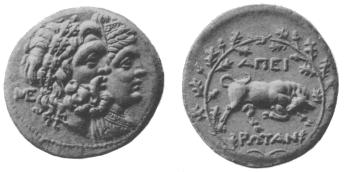
| Heads jugate of Zeus Dodonaeos and Dione. | ΑΠΕΙΡΩΤΑΝ Pushing bull in oak-
wreath (Fig. 185).
AR Didr., 154-140 grs.
|
| Head of Zeus Dodonaeos. [Brit. Mus. Guide, Pl. LV. 16; 17.] | „ Eagle in oak-wreath.
AR Dr., 78-65 grs.
|
| Heads of Zeus and Dione. [B. M. C., Thes., Pl. XVII. 8.] |
„ Fulmen in oak-wreath.
AR (= Victorious) 52-44 grs.
|
| Head of Zeus Dodonaeos. [B. M. C., Thes., Pl. XVII. 9.] |
„ Id.
AR (= ½ Victoriatus) 24-23 grs.
|
The types of the bronze coins for the most part resemble the silver. They present, however, some varieties.
| Head of Dione veiled. | ΑΠΕΙΡΩΤΑΝ Tripod in laurel-wreath
Æ .75
|
| Head of Herakles. | „ Club in oak-wreath.
Æ .5
|
| Head of Artemis. [B. M. C., Thes., Pl. XVII. 12, 14, 15.] | „ Spear-head. Æ .9-.65
|
Although the Epirote coinage, as such, ceased when the country was ruthlessly devastated by the Romans in B.C. 168, nevertheless there are exceptional pieces which appear to have been issued at Dodona in the name of a priest of the temple of Zeus Naios. These are of late style, and are certainly subsequent to the fall of the Republic. They bear the two names of ΑΡΓΕΑΔΗΣ and ΜΕΝΕΔΗΜΟΣ and the title ΙΕΡΕΥΣ.
| Head of Zeus Dodonaeos. | Bust of Artemis. Æ 1.0
|
To Dodona also, in Imperial times, Reinach (Congres arch. d'Athènes, 1905) would attribute the following coin :—
| ΔΙΑ Bust of Zeus Dodonaeos (?). | ΝΑΟΝ Fulmen [Rev. arch. 1905, p. 97].
Æ .6
|